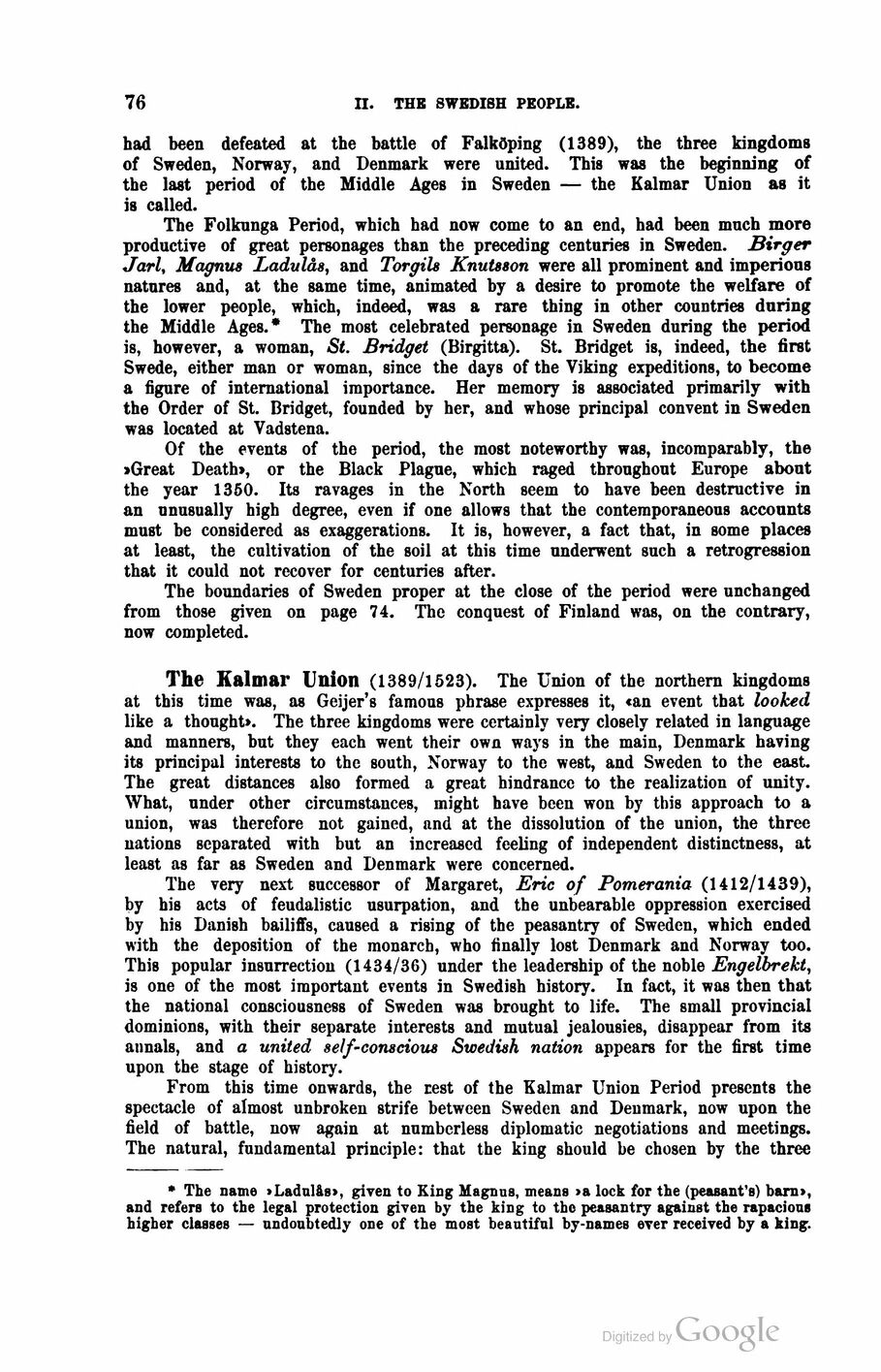
Full resolution (JPEG) - On this page / på denna sida - First part - II. The Swedish People - 1. Survey of its History. By E. Svensén, Author, Stockholm - The Catholic Period (1060/1523)

<< prev. page << föreg. sida << >> nästa sida >> next page >>
Below is the raw OCR text
from the above scanned image.
Do you see an error? Proofread the page now!
Här nedan syns maskintolkade texten från faksimilbilden ovan.
Ser du något fel? Korrekturläs sidan nu!
This page has never been proofread. / Denna sida har aldrig korrekturlästs.
76
II. TH B SWEDISH PEOPLE.
had been defeated at the battle of Falköping (1389), the three kingdoms
of Sweden, Norway, and Denmark were united. This was the beginning of
the last period of the Middle Ages in Sweden — the Kalmar Union as it
is called.
The Folkunga Period, which had now come to an end, had been much more
productive of great personages than the preceding centuries in Sweden. Birger
Jarl, Magnus Ladulås, and Torgils Knutsson were all prominent and imperious
natures and, at the same time, animated by a desire to promote the welfare of
the lower people, which, indeed, was a rare thing in other countries during
the Middle Ages.* The most celebrated personage in Sweden during the period
is, however, a woman, St. Bridget (Birgitta). St. Bridget is, indeed, the first
Swede, either man or woman, since the days of the Viking expeditions, to become
a figure of international importance. Her memory is associated primarily with
the Order of St. Bridget, founded by her, and whose principal convent in Sweden
was located at Vadstena.
Of the events of the period, the most noteworthy was, incomparably, the
»Great Death», or the Black Plague, which raged throughout Europe about
the year 1350. Its ravages in the North seem to have been destructive in
an unusually high degree, even if one allows that the contemporaneous accounts
must be considered as exaggerations. It is, however, a fact that, in some places
at least, the cultivation of the soil at this time underwent such a retrogression
that it could not recover for centuries after.
The boundaries of Sweden proper at the close of the period were unchanged
from those given on page 74. The conquest of Finland was, on the contrary,
now completed.
The Kalmar Union (1389/1523). The Union of the northern kingdoms
at this time was, as Geijer’s famous phrase expresses it, «an event that looked
like a thought». The three kingdoms were certainly very closely related in language
and manners, but they each went their own ways in the main, Denmark having
its principal interests to the south, Norway to the west, and Sweden to the east.
The great distances also formed a great hindrance to the realization of unity.
What, under other circumstances, might have been won by this approach to a
union, was therefore not gained, and at the dissolution of the union, the three
nations separated with but an increased feeling of independent distinctness, at
least as far as Sweden and Denmark were concerned.
The very next successor of Margaret, Erie of Pomerania (1412/1439),
by his acts of feudalistic usurpation, and the unbearable oppression exercised
by his Danish bailiffs, caused a rising of the peasantry of Sweden, which ended
with the deposition of the monarch, who finally lost Denmark and Norway too.
This popular insurrection (1434/36) under the leadership of the noble Engelbrekt,
is one of the most important events in Swedish history. In fact, it was then that
the national consciousness of Sweden was brought to life. The small provincial
dominions, with their separate interests and mutual jealousies, disappear from its
annals, and a united self-conscious Swedish nation appears for the first time
upon the stage of history.
From this time onwards, the rest of the Kalmar Union Period presents the
spectacle of almost unbroken strife between Sweden and Denmark, now upon the
field of battle, now again at numberless diplomatic negotiations and meetings.
The natural, fundamental principle: that the king should be chosen by the three
* The name »Ladulås», given to King Magnus, means >a lock for the (peasant’s) barn>,
and refers to the legal protection given by the king to the peasantry against the rapacious
higher classes — undoubtedly one of the most beautiful by-names ever received by a king.
<< prev. page << föreg. sida << >> nästa sida >> next page >>